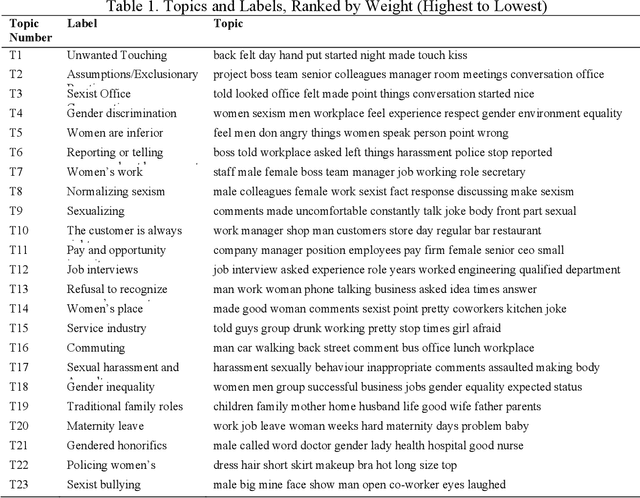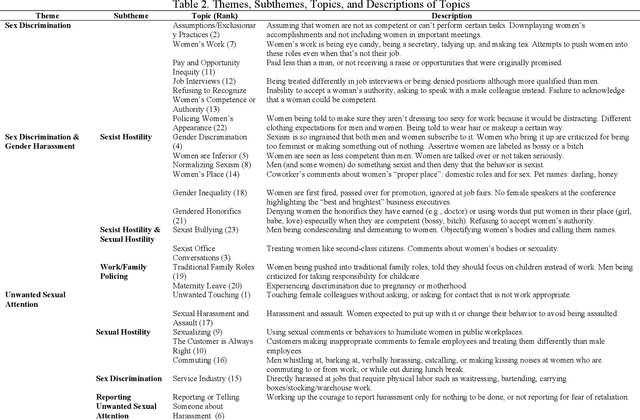Cynthia Nicole White
Unwanted Advances in Higher Education: Uncovering Sexual Harassment Experiences in Academia with Text Mining
Dec 11, 2019Abstract:Sexual harassment in academia is often a hidden problem because victims are usually reluctant to report their experiences. Recently, a web survey was developed to provide an opportunity to share thousands of sexual harassment experiences in academia. Using an efficient approach, this study collected and investigated more than 2,000 sexual harassment experiences to better understand these unwanted advances in higher education. This paper utilized text mining to disclose hidden topics and explore their weight across three variables: harasser gender, institution type, and victim's field of study. We mapped the topics on five themes drawn from the sexual harassment literature and found that more than 50% of the topics were assigned to the unwanted sexual attention theme. Fourteen percent of the topics were in the gender harassment theme, in which insulting, sexist, or degrading comments or behavior was directed towards women. Five percent of the topics involved sexual coercion (a benefit is offered in exchange for sexual favors), 5% involved sex discrimination, and 7% of the topics discussed retaliation against the victim for reporting the harassment, or for simply not complying with the harasser. Findings highlight the power differential between faculty and students, and the toll on students when professors abuse their power. While some topics did differ based on type of institution, there were no differences between the topics based on gender of harasser or field of study. This research can be beneficial to researchers in further investigation of this paper's dataset, and to policymakers in improving existing policies to create a safe and supportive environment in academia.
Hidden in Plain Sight For Too Long: Using Text Mining Techniques to Shine a Light on Workplace Sexism and Sexual Harassment
Jul 01, 2019

Abstract:Objective: The goal of this study is to understand how people experience sexism and sexual harassment in the workplace by discovering themes in 2,362 experiences posted on the Everyday Sexism Project's website everydaysexism.com. Method: This study used both quantitative and qualitative methods. The quantitative method was a computational framework to collect and analyze a large number of workplace sexual harassment experiences. The qualitative method was the analysis of the topics generated by a text mining method. Results: Twenty-three topics were coded and then grouped into three overarching themes from the sex discrimination and sexual harassment literature. The Sex Discrimination theme included experiences in which women were treated unfavorably due to their sex, such as being passed over for promotion, denied opportunities, paid less than men, and ignored or talked over in meetings. The Sex Discrimination and Gender harassment theme included stories about sex discrimination and gender harassment, such as sexist hostility behaviors ranging from insults and jokes invoking misogynistic stereotypes to bullying behavior. The last theme, Unwanted Sexual Attention, contained stories describing sexual comments and behaviors used to degrade women. Unwanted touching was the highest weighted topic, indicating how common it was for website users to endure being touched, hugged or kissed, groped, and grabbed. Conclusions: This study illustrates how researchers can use automatic processes to go beyond the limits of traditional research methods and investigate naturally occurring large scale datasets on the internet to achieve a better understanding of everyday workplace sexism experiences.
 Add to Chrome
Add to Chrome Add to Firefox
Add to Firefox Add to Edge
Add to Edge